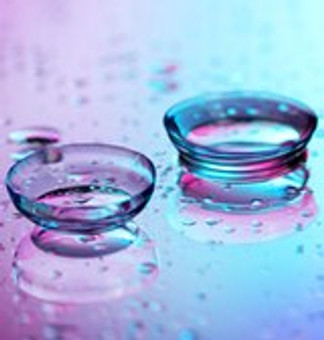There are two main types of contact lens materials that you should consider when choosing which contact lenses best suit your needs. Based on type of lens material they are made of, lenses can be roughly divided into soft and hard lenses.
Soft Contact Lenses
Soft contact lenses are made of gel-like, flexible plastic that is combined with water to allow oxygen to get through the contacts and reach the cornea. This water-containing plastic is also known as hydrogel. This is why this type of contact lenses are comfortable and easy to apply. And in addition, they stay in place and are much easier to get used to than hard contact lenses.
Advantages Of Soft Contact Lenses
As mentioned above, soft contact lenses are easy to get used to. The initial comfort is greater than with RGP contacts. If you don't wear your soft lenses for a week, they'll still be comfortable when you put them on a week later.
Additionally, soft lenses are bigger and they usually move less meaning that they are more stable and thus ideal for sports with risk of impact. And since they do not move, they are less susceptible to the intrusion of foreign objects under the lens, such as dust. The use of these lenses does not usually deform the cornea. Moreover, they are less sensitive to light which isn’t the case with hard or RGP lenses.
Disadvantages Of Soft Contact Lenses
Some of the downsides of soft contact lenses are lower duration and they are more difficult to manipulate. They have less gas permeability than modern rigid materials, also not all optical powers are manufactured. Cleaning and maintenance of soft lenses is more complex and expensive and additionally, they produce more allergic problems and may cause more eye dryness than rigid lenses.
Silicone Hydrogel Contact Lenses
These contact lenses are an improved type of soft contact lenses that are more porous than regular hydrogel lenses and allow even more oxygen to reach the cornea. Furthermore, these lenses enable up to five times more oxygen to reach the cornea than regular hydrogel lenses.
Just like soft lenses, they are made of plastics that are hard when dry but readily absorb water and become soft and gel-like when hydrated. On top of that, increasing the oxygen supply to the eye is potentially beneficial for all contact lens wearers, especially considering that many wearers are not complying with their opticians’ instructions regarding proper lens wear and replacement.
Some of disadvantages of silicone hydrogel lenses are that the silicone material tends to attract more lipid deposits, which may cause blurry vision and discomfort, in some patients. Also, they are generally more expensive than non-silicone lenses, so a more price-conscious consumer may not prefer this option.
Disposable Soft Lenses
This type of lenses was designed to be warn for a short time. Disposable contact lenses are great for people with allergies and those who are concerned about getting eye infections from the build-up of bacteria and dirt under the lens. These contact lenses require minimal cleaning and disinfection before being discarded. Today’s soft contact lenses are available as non-disposables, monthly or weekly disposables, and daily disposables.
Daily Wear & Extended Wear Soft Lenses
Soft contact lenses are also available for extended and daily wear. Daily wear contacts are intended to be worn during the day and removed for nightly cleaning and disinfecting. Daily wear lenses can be reused until their intended discard date.
Extended wear soft contact lenses can be worn while sleeping but must be removed for cleaning and disinfecting once a week. Overnight use may pose a risk of eye infections so caution should be used even with lenses that are designed for extended wear.
Hard Contact Lenses
Hard contact lenses are today known as rigid gas permeable contact lenses which are also called GP lenses, gas permeable lenses, RGP lenses and oxygen permeable lenses. This type of lenses has come a long way since the 1970s and they shouldn’t be confused with old-fashioned hard contact lenses which are no longer in use.
Hard contact lenses were made of a type of plastic called poly methyl methacrylate (PMMA). Before 1971 almost all contact lenses were made from PMMA, which is also called acrylic or acrylic glass, as well as Plexiglas, Lucite, Perspex and others. Even though PMMA has excellent optical properties, and it’s lightweight and shatter-resistant, it is impermeable to oxygen and other gasses. And since cornea needs a significant amount of oxygen to stay healthy, PMMA lenses were very uncomfortable and impossible to wear.
In the late 1970s, gas permeable contact lenses were first introduced. Most GP lenses incorporate silicone, which makes them more flexible than PMMA. And silicone is a material that is oxygen permeable, which means that oxygen can pass directly through GP lenses to keep the cornea healthy.
Moreover, modern RGP contact lenses allow more oxygen to reach the cornea than most soft contact lenses. Because of this RGP contact lenses are made larger than PMMA lenses. These design changes make modern rigid RGP lenses more comfortable and easier to get used to than old-fashioned hard contacts and also keep the lenses more securely on the eye.
Advantages Of RGP Contact Lenses
RGP lenses retain their shape when you blink which in turn provides sharper vision. This happens because they are made of a firm plastic material.
These lenses are extremely durable and can’t be torn easily. Also, unlike soft contact lenses, RGP lenses aren’t made of materials that contain water, so protein and lipids from your tears do not adhere to GP lenses as easily as they do to soft lenses. These lenses can last for years with just a little care, as long as you don't require a prescription change, of course.
Disadvantages Of RGP Contact Lenses
Unlike soft lenses which are instantly comfortable,
RGP lenses require an adaptation period before they are as comfortable as soft contacts. In order to achieve maximum comfort with gas permeable contacts, you need to wear them regularly (though not necessarily every day).
Additionally, since GP lenses are smaller in size than soft lenses, there is a greater risk of gas permeable lenses dislodging from the eye during sports or other activities. And because gas permeable lenses are designed to move on the eye when the wearer blinks, there is a higher risk of dust and debris getting under the lenses, causing discomfort or a possible abrasion to the cornea.
Hybrid Contact Lenses
Hybrid contact lenses are designed to provide wearing comfort that rivals soft or silicone hydrogel lenses, combined with the crystal-clear optics of gas permeable lenses. Hybrid lenses have a rigid gas permeable central zone, surrounded by a “skirt” of hydrogel or silicone hydrogel material. Hybrid lenses are great for patients with astigmatism, as the GP lens is able to mask most, if not all, of the corneal astigmatism. Despite these features, hybrid contact lenses are more difficult to fit and are more expensive to replace than soft and silicone hydrogel lenses. Also, hybrid lenses do not correct for lenticular astigmatism. Hybrid lens wearers will need proper training with insertion, removal and lens care. This new modality is easy for some and difficult for others.
Taking into consideration all the above-mentioned advantages and disadvantages of both soft and hard contact lenses can help determine the best options for you. Whether you’re shopping for soft or hard contacts, shop our site today to find discount contact lenses. Save yourself from getting into rush hours and buy your contacts online.
Save yourself from getting into rush hours and buy your contacts online.








